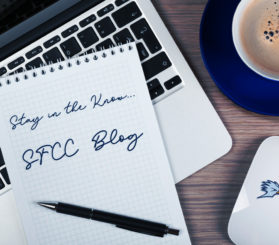Originally Posted: April 22, 2020
 Strong communication skills are the key to success professionally and personally. Here are some tips that will not only help you communicate well with your instructors but also will enhance your professional career.
Strong communication skills are the key to success professionally and personally. Here are some tips that will not only help you communicate well with your instructors but also will enhance your professional career.
- Use instructors preferred way of communication
Every instructor has a preferred way to communicate with students. Some instructors will state this in the syllabus or make it clear at the beginning of the course. If you’re not sure, be sure to ask them what works best. When in doubt, use email. Other methods include Canvas email, social media direct messaging, texting or calling.
- Use student email
It is best to use your student email when emailing instructors. This way they will know right away it is from a student and is college related. This will ensure a faster response time.
- Greet them with preferred name
It’s highly important to address your instructor by their preferred name or title. Some examples of titles include first name, Mr./Mrs./Ms./Miss, Dr., professor, or a nickname. Therefore, it would be offensive to address an instructor who prefers the title of “Dr.” by their first name. Most instructors will state this on their syllabus or on the first day of class, but just ask if it’s not clear.
- Be nice and polite
It is hard to detect a person’s tone in email, such as sarcasm and humor. Therefore, it’s best to be polite while remaining professional. Never email an instructor when you are upset. Take some time to re–evaluate the situation, then come back and explain the problem with professionalism. Avoid typing in all capital letters, abbreviated words or phrases (INK, BTW, LOL, etc.) or slang.
- State the course you’re in
Instructors teach multiple classes, so it makes it way easier if you state which course you’re in. This way they will be able to get a sense of which assignment you’re referring to, and they will most likely be able to answer faster.
- Identify the assignment you need help with
Just as it’s important to identify your course, it is also important to identify which assignment you’re referring to. Be as clear as possible by referencing the title of the assignment, question number, state the question, and due date if necessary. If it’s a visual project, maybe it will help to include a picture of what you’re referring to. Include anything that will help your instructor know what you need help with.
- Be clear and direct
It’s easy to ramble on and write multiple paragraphs to your instructor. Instructors teach several classes and have many students, so put yourself in their shoes. It will make it so much easier for them if you keep your message short and to the point.
- Give time for response
Try to avoid emailing your instructor last minute. If you send an email at midnight about an assignment due in the morning, they aren’t going to be able to answer in time. Therefore, it’s important to not procrastinate on your assignments in case you do run into an issue and need help. Don’t expect a response from an instructor after business hours (8 a.m. to 5 p.m.) or on weekends. Try to only send emails during business hours if you can. If you do send an email and need a fast response time, mark it as high importance.
- Proofread
Proofreading is very important. Something as simple as a small grammar mistake can make you seem unprofessional. Emailing isn’t texting so spell out every word and avoid abbreviations. After you proofread it, have a friend review it if possible. Along with being grammatically correct, it is important to use correct punctuation. Avoid using exclamation points because tone is hard to communicate through email.
- Use readable fonts and font sizes
An email is useless if you can’t read it. Use a readable font, usually the default font will work fine. Don’t use tiny fonts, but also avoid huge font sizes. Avoid changing colors as this will affect the contrast and readability. Bold important information and headings. Organize information and separate into paragraphs.
- Give time options for meetings
If you’re asking to meet with your instructor, be sure to give them a range of time options for three different days. This is efficient and will lessen the amount of emails taken to choose a time that works for both people. You can say something along the lines of “I am free to meet any of the following times. Please let me know what works best for you. If none work, we can figure something else out.” Know when your instructors hold office hours for consultations and request meetings during those times when possible.
- Direct subject line
The subject line is the first thing that will catch their eye. Be direct and short. The subject line needs to make it clear what the email is about. Longer subject lines have more of a chance at being cut off the screen.
- Thank them for their time
Make sure to thank your professors for their time and help. Thanking them is a great way to close the email.
- Create a signature
Along with thanking them at the end of the email, you can go the extra step by creating an email signature. Be sure to include your full name and ways to contact you. This looks more professional and makes it easy for your instructor to remember who the email is from.
- Respond right away
It’s important to maintain your professionalism throughout the email conversation. Therefore, it’s important to respond as fast as possible. If you’re busy and unable to respond, a great tip to follow is to respond back with “I appreciate your response, I will get back to you at this time.” You can say a specific time or sometime tonight or tomorrow. This will let them know that you aren’t ignoring them or unappreciative of their time. This is a great tip to follow with communicating online with anyone.
Professionalism is key when communicating with instructors. Always be kind and respectful. As always, remember that everything communicated online is permanent and can be found at any time and can never be fully deleted. When in doubt, have a friend read over your email to make sure what you’re trying to communicate is clear.
Written by Megan Spencer, Social Media and Digital Communications Coordinator at State Fair Community College.
 About the Author
About the Author
Hi, I’m Megan! I run State Fair Community College’s social media. I grew up with a creative passion and have always loved drawing, painting, and crafting. My educational background is in graphic design and marketing. I love to help people, which is one of the reasons I started writing these blogs for SFCC’s students. It’s about community!
SUBMIT A BLOG TO SFCC
Would you like to publish a blog to State Fair Community College? We’re now accepting submissions from students, staff, and faculty. Email your blog submission to Megan Spencer at mspencer8@sfccmo.edu


